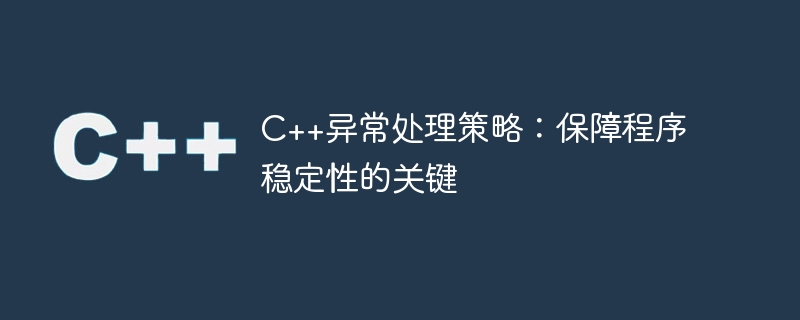
C is a programming language widely used in software development. Its powerful functions and flexibility make many developers choose to use it to build complex applications. However, since various errors and exceptions may exist in the program, in order to ensure the stability of the program, correct handling of exceptions is crucial. This article will explore C exception handling strategies and techniques to provide developers with some guidance and help.
First, let us review the basic concepts of C exception handling. In C, exceptions refer to errors or abnormal conditions that occur during program operation, such as division-by-zero errors, memory overflows, and invalid inputs. When an exception occurs, the program is interrupted and begins looking for exception handling code blocks to restore as much normality as possible. The core idea of exception handling is to separate the code that may cause exceptions from the code that handles exceptions to improve the readability and maintainability of the program.
The following are several commonly used C exception handling strategies:
- Use try-catch block: try-catch block is the most basic exception handling structure. By writing code that may throw exceptions in try blocks and using catch blocks to catch and handle exceptions, we can avoid the program from crashing due to exceptions. In the catch block, we can perform corresponding processing according to the exception type, such as outputting error information, performing recovery operations, or throwing new exceptions.
- Throw custom exceptions: C allows us to define our own exception types to better handle specific exception situations. By inheriting the std::exception class or its derived classes, we can create custom exception classes and throw these exceptions when needed. In this way, we can define different exception classes based on specific application requirements and use them to distinguish and handle different types of exceptions.
- Use RAII technology: RAII (Resource Acquisition Is Initialization) is a C programming technology used to manage the acquisition and release of resources. By using RAII technology, we can ensure that allocated resources are released correctly under any circumstances, thus avoiding resource leaks and memory errors. When an exception occurs, RAII technology automatically calls the object's destructor to ensure the correct release of resources.
- Avoid null pointer exception: Null pointer exception is one of the common errors in C. To avoid NullPointerException, we can take some precautions. For example, before using a pointer, we can check whether the pointer is null; before deleting the pointer, we can use a conditional statement to determine whether the pointer is null.
In addition to the above common exception handling strategies, there are some other precautions and techniques that we need to pay attention to:
- Performance impact of exceptions: Exception handling may Have a certain impact on the performance of the program. Therefore, when writing code, you need to carefully weigh the balance between the use of exceptions and performance to avoid overuse of exceptions.
- Exception safety: Exception safety means that the program can still maintain a correct and usable state when an exception occurs. In order to achieve exception safety, we can use some techniques, such as using smart pointers, using transaction processing, etc.
- Exception specification: An exception specification is a convention that specifies the types of exceptions that a function can throw. By using exception specifications, we can improve the readability and maintainability of our programs to a certain extent. However, it is important to note that exception specifications are not part of the C standard and may cause compiler errors in some cases.
In general, C exception handling strategy is the key to ensuring program stability. Through the reasonable use of try-catch blocks, custom exceptions, RAII technology, etc., we can effectively capture and handle exceptions and improve the reliability and availability of the program. At the same time, we also need to pay attention to the performance impact of exceptions, ensure exception safety, and use exception specifications with caution. I hope this article can provide some help and guidance for C developers in exception handling.
The above is the detailed content of C++ exception handling strategy: the key to ensuring program stability. For more information, please follow other related articles on the PHP Chinese website!






